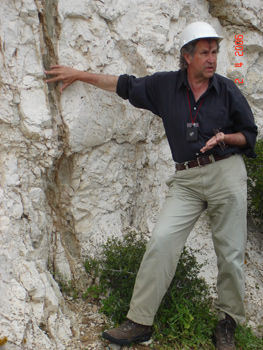Research Homepage for Robert Riding

Algal and bacterial carbonates
Algae, bacteria and their calcification processes are environmentally very sensitive. The conditions they respond to range from local to regional and global. During long histories, often spanning 100s and in some cases 1000s of millions of years, these organisms have experienced profound variations in Earth surface conditions. The main aim of my research is to understand how the geological records of calcified algae and bacteria reflect long-term changes in major environmental factors - including climate, sea-level, seawater chemistry, and atmospheric composition.
How algal and bacterial biocalcification can reflect global changes in temperature and seawater chemistry BiocalcificationMuch of the marine fossil record reflects the ability of organisms to create shells made of calcium carbonate. These shells can be so abundant that they accumulate as limestones. Many organisms appear to be able to closely control the biocalcification processes by which shells are constructed. It can be crucially important for them to do this, because shells provide protection and support that can be essential for survival. In these organisms, shell formation does not seem to be affected by external influences such as temperature and water chemistry. But there are organisms, and calcified algae and bacteria include good examples of these, whose calcification is much more sensitive to external influence. It could be that they do not rely so heavily on their shells for survival, or that they are simply not able to overcome external factors that reduce their calcification.
Seawater chemistryThe significance of weakly controlled biocalcification is that the geological record of algae and bacteria can reflect variations in seawater chemistry that affect calcification. It is well known that cyanobacteria and green algae such as dasycladaleans can survive without calcification, but will calcify when conditions are favourable. The abundance of calcified marine cyanobacteria, and the diversity of dasycladaleans, show marked fluctuations over geological time. These variations are likely - at least in part - to reflect changes in biocalcification directly influenced by seawater chemistry, particularly saturation state for carbonate minerals.
ResearchOne of my key goals is to establish links between these variations in the abundance of these organisms and changes through time in seawater chemistry.
There are real obstacles to this research. In the first place, the geological records of these organisms are only now becoming clear and many more details are required. Secondly, these records will of course not only reflect seawater chemistry and calcification, but also the types of evolutionary responses to changing ecological and environmental conditions that are common to all organisms; so these patterns will be superimposed and interactive. Thirdly, understanding past changes in seawater chemistry is fraught with difficulties: direct information from fluid inclusions is only now, and gradually, becoming available and it is necessary to rely heavily on modeled estimates that must suffer from all the uncertainties of the assumptions they are based on.
On the positive side, rapid progress is being made on all these fronts and, if you accept the underlying premise, past fluctuations in seawater chemistry are already embedded in the fossil records of organisms such as calcified cyanobacteria and dasyclad algae. If so, all that needs to be done is to go and interpret the data!
Atmospheric changesAlgae and cyanobacteria are photosynthetic organisms and consequently are sensitive to changes in carbon availability. When CO2 declines many of these organisms induce mechanisms to concentrate carbon in the cells to maintain efficient photosynthesis. In cyanobacteria, such CO2-concentrating mechanisms (CCMs) include bicarbonate pumps that result in pH increase adjacent to the cell, promoting calcification. So it is likely that cyanobacterial calcification, and possibly calcification in some algal groups, is enhanced when CCMs are induced in response to fall in atmospheric CO2 levels.
A proxy for CO2 decline?This provides another interesting possible link between algal-bacterial biocalcification and the global environment. For example, the inception of cyanobacterial calcification in the mid-Proterozoic could reflect CO2 decline. CCMs will also promote whitings - nucleation of crystals adjacent to blooms of phytoplankton. The abundance of carbonate mud mounds near the Devonian-Carboniferous transition could reflect widespread whitings produced by blooms in which CCMs were triggered as atmospheric CO2 steeply declined.